Advancements Help Infants with Spinal Muscular Atrophy
By Joan Tupponce
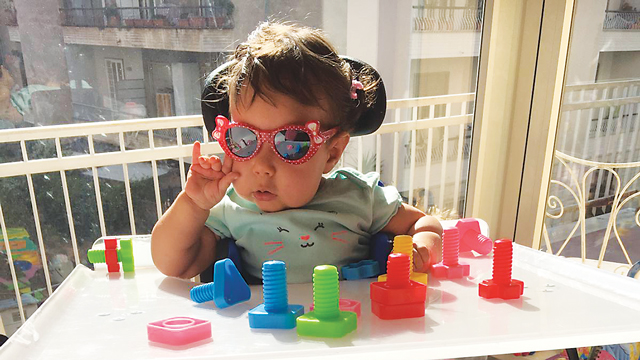
When Gislane Lima mentioned her infant daughter Maya wasn’t rolling over like other babies her age, the West End mom could sense something was wrong by the expression on her pediatrician’s face.
“The doctor had tears in her eyes,” Gislane says.
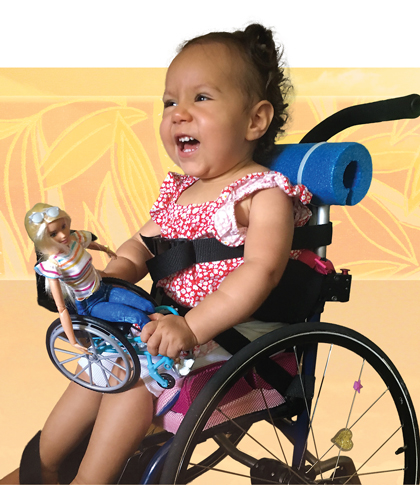 It was the summer of 2018. Maya’s case was referred to a pediatric neurologist, who then referred the family to Amy Harper, MD, director of the Pediatric Neuromuscular Clinic at Children’s Hospital of Richmond at VCU.
It was the summer of 2018. Maya’s case was referred to a pediatric neurologist, who then referred the family to Amy Harper, MD, director of the Pediatric Neuromuscular Clinic at Children’s Hospital of Richmond at VCU.
Dr. Harper examined Maya and told the Limas – Gislane and her husband Fernando – there was a chance Maya had spinal muscular atrophy (SMA). When Gislane, a registered nurse, investigated the condition, it took her breath away. “I thought, what’s going on?” she says.
The leading genetic cause of death for infants, SMA causes weakness and wasting of muscle because patients lose lower motor neurons (nerve cells) that control movement. If the condition is untreated, babies with the most severe form of SMA – SMA type 1, which Maya has – will die by the age of two from respiratory failure without the use of a ventilator. Most little ones also lose the ability to eat, requiring them to have a feeding tube.
Life-Changing Early Action
When Maya was born, everything seemed normal. Between the 3- and 4-month mark, however, she started losing movement. She didn’t have any head control. “She was floppy,” Gislane says. “She was not officially unable to swallow, but she was on that route.”
At first, Gislane remembered thinking Maya was sluggish, but thought it might be due to the fact that she was a chubby baby. “Everybody thought she was being lazy,” Gislane says.
Typically, babies who have SMA will present symptoms before six months of age. “But initially, things can look very normal,” Dr. Harper says. “The hallmark for predicting is an infant who has low muscle tone, weakness, and no reflexes. If you see this combination in a baby, you have to get testing that day.”
Maya was four months old when Dr. Harper first saw her. The doctor was able to conduct rapid testing for SMA, which is available for more urgent cases. She had ordered the test as soon as she heard about Maya from her colleague; Maya’s diagnosis was confirmed in less than a week.
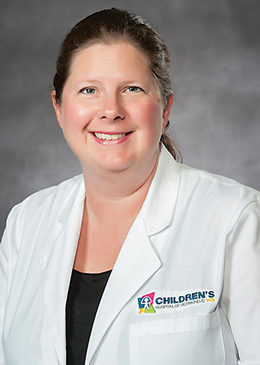
Maya’s decline between four and six months was significant and frightening, Gislane remembers. “She couldn’t hold her head up or move her legs. She didn’t do anything against gravity.”
When the Limas first heard the SMA diagnosis, it was heartbreaking, but the couple didn’t spend time grieving. Instead they looked for options.
In order to learn more about the condition, Gislane contacted Cure SMA, an organization that provides support and resources. “They teach you a lot,” she says.
The family had support not only from the organization, but also through Dr. Harper. “She gave us many options and we made the choice. She supported us along the way. She has been fantastic,” Gislane says.
At the time Maya was tested, the only approved medication for SMA was Spinraza, a spinal injection that after the induction phase is administered every four months for the child’s lifetime. But there was also an ongoing clinical research trial at the time for a single-dose gene therapy given intravenously (a drug that was eventually named Zolgensma). If given early enough, the gene therapy would result in the child’s ability to obtain more typical motor milestones. Even in older infants, the therapy can prevent the need for ventilator dependence, and most children achieve the ability to sit.
“Zolgensma takes a virus associated with a respiratory infection and modifies it. They insert the gene Maya is missing into the virus. The virus is then delivering genetic information to the motor neuron for Maya’s body to make the protein,” Dr. Harper says. “It is saving the non-working SMA gene that is missing from her.”
Zolgensma is only approved for babies less than two years old with the most severe form of the disease, SMA type 1. “It is nice to have this new medication on board where we can do a one-time infusion and improve the outcome,” Dr. Harper says.
At the time Maya was diagnosed, all the U.S. clinical trial sites were closed for enrollment. “We had to find Maya a study site that accepted international patients,” Dr. Harper says, adding that time was of the essence.
Fortunately, there was one available that was actively recruiting patients. A clinical trial site in Italy had an opening, but Maya would have to remain there for at least eighteen months. “Within a week of meeting Maya, I was talking about international clinical research sites,” Dr. Harper says. “There are a lot of hoops to jump through for international patients. You have to think about visas, passports, and insurance and get all of these things in place on an emergency basis. We had less than a month for her [Maya] to still be trial-eligible.”
Gislane was enthusiastic about the gene therapy for Maya because it was a one-time dose. “Dr. Harper asked me if I understood we would have to stay for eighteen months,” Gislane says. “If that would be the best outcome for my daughter, then I said I would do it.”
Extraordinary and Necessary Steps
In late summer of 2018, Maya was accepted into the trial and shortly thereafter, the family was in the plane on their way to Italy. Maya was infused with the gene therapy right before she was six months old.
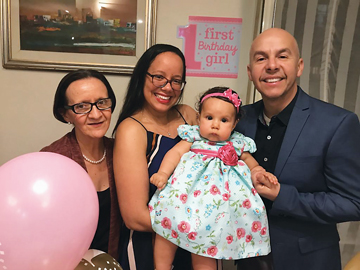
“For the last three months, because she was doing so well, they allowed her to come back to the U.S., and we traveled to Italy once a month,” Gislane says.
The family’s final trip to Europe was in September 2019, several months before the pandemic forced countries to shut down. “Thank God we got it all in before COVID-19,” Gislane says, noting that now they have more support as her mother lives with the family and is Maya’s primary caregiver.
Maya’s Journey Forward
Today, Maya is also taking a newer FDA-approved medication called Evrysdi. An oral medication for all subtypes of SMA that was approved in August 2020, Maya was the first child in the U.S. to receive this medication.
“As soon as it was approved, I was interested in starting Maya on the medication to see if it could give her more relief. The other medications saved Maya’s life,” Gislane says. “Within the first month, she improved. She had better head control and she gained some movement and balance. She’s been improving since then.”
Because of the gene therapy, Maya doesn’t require machine-support for breathing. “It [gene therapy] gave Maya the ability to improve her breathing and head control. She still doesn’t walk or crawl, but she has been doing really well.”
The Limas notice each day that Maya, who will turn three in March, has a little more strength and balance. She is able to bear weight when standing up, for example. “Those are small things, but we can see improvement,” Gislane says.
At home, Maya has a special frame so she can be in an upright position. A gait trainer helps her take a step or two. She also has manual and power wheelchairs donated by Children’s Assisted Technology Service, and Reach Cycles has donated a hands-and-feet tricycle to the family. “She can go wherever she wants,” Gislane says. “She can propel the manual wheelchair and drive the power wheelchair by herself. She can go to school and go any place any other child can go.”
Maya has had great support from the physical therapy team at CHoR at VCU. She also has physical therapy sessions at Richmond Hope Therapy Center, part of Richmond Community Hospital, and through other resources based in Henrico County.
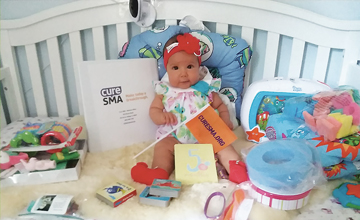
Dr. Harper and her staff enjoy seeing Maya, who is very expressive and chatty during visits. “She’s a superstar princess when she comes into the clinic,” she says. “She is very motivated and works very hard in therapy.”
The Limas are grateful for Dr. Harper and the medications that are improving Maya’s quality of life. “I am hopeful that she will have a better future because this country has equal rights for [people with] all disabilities,” says Gislane. “I don’t think her disability will reduce the things she can do. We are happy for Maya that she will be a happy child.”
Genetic Screening for SMA
It is estimated that worldwide, one in 5,000 to 10,000 babies is born with one of the sub-types of SMA each year. One in thirty-five parents could be a carrier of the gene that causes SMA. “Obstetricians are now screening new moms to see if they are carrying the gene,” Dr. Harper says. “If she is, the father is tested as well. If both parents are carrying the gene, there is a one in four chance of SMA [in the child].”
In 2018, Virginia decided that SMA would be added to the newborn screen, primarily because of the implications of gene therapy as a treatment. The addition of SMA testing to the newborn screen is set to be implemented in 2021. Referral sites, including CHOR at VCU, are preparing for babies who have the SMA diagnosis now. “It is our goal to provide these babies with the earliest treatment and best possible outcome,” Dr. Harper says.
